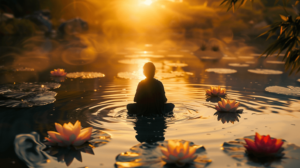Introduction: The Intersection of Eastern Philosophy and Higher Consciousness

In a world that often feels fragmented and chaotic, the quest for higher consciousness offers a pathway to inner peace, self-realization, and a deeper connection with the universe. This pursuit is not new; it has been at the heart of many spiritual traditions for millennia. However, in the modern era, the teachings of Eastern philosophy have gained renewed relevance as individuals seek to transcend the limitations of ordinary awareness and experience a state of unity and profound insight.
Eastern philosophy, encompassing traditions such as Buddhism, Hinduism, Taoism, and Zen, provides a rich tapestry of wisdom that guides seekers toward higher consciousness. These traditions offer diverse yet interconnected practices and principles that help individuals dissolve the ego, cultivate mindfulness, and align with the natural flow of life. But what does it truly mean to attain higher consciousness, and how can the ancient teachings of the East inform our modern quest?
This article delves deep into the core fundamentals of Eastern philosophy, exploring its timeless relevance to the pursuit of higher consciousness. By deconstructing conventional assumptions and offering novel insights grounded in both ancient wisdom and contemporary research, this guide aims to reshape your understanding of consciousness and inspire you to embark on a transformative journey.
Understanding Higher Consciousness

At its core, higher consciousness refers to an elevated state of awareness in which an individual transcends the limitations of the ego and experiences a profound connection with the universe. This state is often described as a sense of oneness, where the boundaries between self and other dissolve, leading to a direct experience of the interconnectedness of all things.
In various spiritual traditions, higher consciousness is equated with enlightenment, self-realization, or spiritual awakening. However, it is essential to recognize that higher consciousness is not a static state or a final destination. Instead, it is a dynamic process of continuous growth and expansion of awareness. This process involves not only intellectual understanding but also experiential insight, where knowledge is integrated into one’s being and daily life.
The journey to higher consciousness is marked by a shift from identification with the ego—the part of us that sees itself as separate and distinct—to a recognition of the deeper, universal aspects of our being. This shift is accompanied by a heightened sense of presence, clarity, and compassion, as well as a diminishing of fear, attachment, and suffering.
The Journey to Higher Consciousness
The pursuit of higher consciousness is often portrayed as a heroic journey, akin to the classic “hero’s journey” found in mythology. This journey involves a departure from ordinary awareness, an exploration of deeper truths, and a return to the world with newfound wisdom. However, unlike the hero’s journey, which typically follows a linear narrative, the journey to higher consciousness is cyclical and non-linear. It involves periods of progress and regression, light and darkness, certainty and doubt.
One of the key aspects of this journey is the gradual dissolution of the ego. The ego, which serves as the organizing principle of our everyday consciousness, is necessary for navigating the world, but it also creates a sense of separation and limitation. As individuals progress on the path to higher consciousness, they begin to see through the illusions created by the ego and experience a more expansive and unified sense of self.
This journey is not without its challenges. The process of letting go of deeply ingrained patterns of thought and behavior can be unsettling and even painful. Yet, it is through this process of surrender and transformation that individuals can access higher states of consciousness. Practices such as meditation, mindfulness, and self-inquiry play a crucial role in facilitating this inner transformation, helping individuals move beyond the confines of the ego and experience the boundless nature of consciousness.
Why Higher Consciousness Matters
In today’s fast-paced, materialistic world, the pursuit of higher consciousness may seem like a luxury or an abstract ideal. However, higher consciousness has profound implications for both individual well-being and collective transformation. At the individual level, attaining higher consciousness can lead to greater emotional resilience, mental clarity, and a deep sense of inner peace. It can also foster a sense of purpose and meaning, as individuals come to understand their place in the larger scheme of things.
On a collective level, the cultivation of higher consciousness can contribute to a more harmonious and compassionate society. As more individuals awaken to their interconnectedness with others and the environment, they are likely to act in ways that promote the well-being of all beings. This shift in consciousness can lead to a reimagining of social, economic, and environmental systems, moving us closer to a world that reflects the values of justice, sustainability, and empathy.
The pursuit of higher consciousness is not merely a personal endeavor; it is a response to the urgent challenges of our time. By expanding our awareness and aligning with the deeper truths of existence, we can contribute to the creation of a more enlightened and harmonious world.
Core Concepts of Eastern Philosophy Related to Higher Consciousness

Non-Duality (Advaita Vedanta)
One of the most profound contributions of Eastern philosophy to the understanding of higher consciousness is the concept of non-duality, particularly as articulated in Advaita Vedanta. Non-duality, or Advaita, teaches that the ultimate reality is non-dual—that is, it is not divided into subject and object, self and other, or any other binary distinctions. According to this philosophy, the true nature of the self (Atman) is identical with the ultimate reality (Brahman), and the perception of separateness is an illusion (Maya).
In the context of higher consciousness, non-duality suggests that the realization of oneness is the key to transcending the limitations of the ego. When an individual recognizes that their true self is not separate from the universe but is, in fact, the universe itself, they experience a profound shift in consciousness. This realization dissolves the barriers of fear, attachment, and suffering, leading to a state of inner freedom and peace.
Advaita Vedanta offers various practices to facilitate this realization, including self-inquiry (Atma Vichara), meditation, and the study of sacred texts (Shravana). Self-inquiry, popularized by the modern sage Sri Ramana Maharshi, involves asking the question “Who am I?” and tracing the sense of “I” back to its source. This practice helps individuals dismantle the layers of identification with the body, mind, and ego, revealing the true nature of the self as pure consciousness.
Mindfulness and Presence (Buddhism)
Mindfulness, or Sati, is a central practice in Buddhism and plays a crucial role in the cultivation of higher consciousness. Mindfulness involves paying attention to the present moment with an attitude of non-judgmental awareness. By being fully present in each moment, individuals can observe their thoughts, emotions, and sensations without becoming entangled in them. This practice helps to dissolve the ego’s grip on the mind, allowing for a direct experience of reality.
In Buddhism, mindfulness is closely linked to the concept of emptiness (Shunyata), which refers to the inherent lack of intrinsic self or essence in all phenomena. By observing the impermanent and interdependent nature of all things, practitioners of mindfulness can develop insight into the true nature of reality, which is free from the dualistic distinctions of self and other, subject and object.
The practice of mindfulness is often paired with meditation, particularly Vipassana or Insight Meditation. Vipassana involves observing the flow of thoughts, sensations, and emotions without attachment, leading to the gradual purification of the mind and the awakening of higher consciousness. This practice is not limited to formal meditation sessions but can be integrated into everyday activities, such as walking, eating, and breathing.
The Tao and Wu Wei (Taoism)
Taoism, an ancient Chinese philosophy, offers a unique perspective on higher consciousness through the concepts of the Tao and Wu Wei. The Tao, often translated as “the Way,” is the underlying principle that governs the universe. It is the source of all existence, yet it is beyond human comprehension and cannot be defined or named. The Tao represents the ultimate reality, which is both immanent and transcendent.
Wu Wei, often translated as “effortless action” or “non-doing,” is the practice of aligning with the Tao by acting in harmony with the natural flow of life. This does not mean inaction but rather acting without force, resistance, or attachment. Wu Wei involves trusting in the natural unfolding of events and responding to situations with spontaneity and ease.
In the context of higher consciousness, Wu Wei represents the state of being in which the individual is fully attuned to the Tao. In this state, there is no separation between the self and the universe, and actions arise naturally from a place of deep inner alignment. This state of effortless action is often described as a flow state, where the individual experiences a sense of unity with the world and a profound sense of peace and contentment.
Kundalini and Chakras (Hinduism)
In Hinduism, the concept of Kundalini refers to a dormant spiritual energy located at the base of the spine. When awakened, Kundalini rises through the central energy channel (Sushumna) and activates the chakras, or energy centers, along the spine. This process leads to the elevation of consciousness and the realization of the self as one with the divine.
The chakra system consists of seven primary chakras, each corresponding to different aspects of consciousness and spiritual growth. As Kundalini rises and activates each chakra, the individual experiences a deepening of awareness and an expansion of consciousness. The awakening of Kundalini is often accompanied by intense physical, emotional, and spiritual experiences, which can lead to profound transformation.
The ultimate goal of Kundalini awakening is the activation of the crown chakra (Sahasrara), which is associated with the experience of cosmic consciousness and unity with the divine. In this state, the individual transcends the limitations of the ego and experiences a direct connection with the universal consciousness.
Zen and the Concept of ‘No Mind’ (Mushin)
Zen Buddhism, particularly as practiced in Japan, emphasizes the concept of ‘No Mind’ (Mushin), a state of mental clarity and stillness free from thoughts, desires, and attachments. In the state of Mushin, the mind is empty yet fully alert, allowing for spontaneous and intuitive action. This state is often cultivated through practices such as Zazen (sitting meditation) and Koan study (contemplation of paradoxical questions or statements).
Mushin is closely related to the concept of Satori, or sudden enlightenment, in Zen. Satori is an experience of awakening in which the individual realizes the true nature of reality and transcends the dualistic distinctions of self and other. This realization is often described as a “direct seeing” into the nature of existence, free from conceptual thought.
The practice of Zen, with its emphasis on simplicity, mindfulness, and direct experience, offers a powerful pathway to higher consciousness. By cultivating the state of No Mind, practitioners can access a deeper level of awareness and experience the world with clarity, presence, and compassion.
Practical Paths to Higher Consciousness in Eastern Philosophy

Meditation
Meditation is one of the most effective and widely practiced methods for cultivating higher consciousness. In Eastern traditions, meditation is not merely a relaxation technique but a profound practice that leads to the transformation of consciousness.
Vipassana Meditation (Buddhism): Vipassana, or Insight Meditation, is a practice of observing the mind and body with mindfulness and equanimity. By observing thoughts, emotions, and sensations without attachment, practitioners gain insight into the impermanent and interdependent nature of all phenomena. This practice helps dissolve the ego and leads to the awakening of higher consciousness.
Zazen (Zen Buddhism): Zazen, or seated meditation, is a central practice in Zen Buddhism. It involves sitting in a stable posture, focusing on the breath, and observing the mind without attachment. Zazen cultivates the state of No Mind, allowing practitioners to experience the world with clarity and spontaneity. It is a practice of direct seeing, where the individual transcends conceptual thought and realizes the true nature of reality.
Transcendental Meditation (Hinduism): Transcendental Meditation (TM) is a simple, natural technique that involves silently repeating a mantra to transcend ordinary thought and access a state of pure consciousness. This state, known as the Transcendent, is characterized by deep rest, inner peace, and the absence of mental activity. TM is practiced for 20 minutes twice a day and is said to lead to greater creativity, clarity, and higher states of consciousness.
Yoga and Physical Practices
In Eastern traditions, physical practices such as yoga and Tai Chi are not merely exercises but integral parts of the spiritual path. These practices help cultivate higher consciousness by aligning the body, mind, and spirit.
Hatha Yoga (Hinduism): Hatha Yoga is a physical practice that involves postures (asanas), breath control (pranayama), and meditation. The practice of Hatha Yoga helps purify the body and mind, balance the energy centers (chakras), and prepare the practitioner for higher states of consciousness. By cultivating physical and mental discipline, Hatha Yoga leads to the awakening of Kundalini and the realization of the self as one with the divine.
Tai Chi (Taoism): Tai Chi is a Chinese martial art that emphasizes slow, flowing movements, deep breathing, and meditation. It is often described as “meditation in motion” and is practiced for both physical health and spiritual development. The practice of Tai Chi helps cultivate the flow of vital energy (Qi) and align the practitioner with the Tao. By moving with the natural flow of life, practitioners experience a sense of harmony and higher consciousness.
Breathwork (Pranayama)
Breathwork, or Pranayama, is a key practice in Hinduism and other Eastern traditions for controlling and directing the life force (Prana) to achieve higher states of consciousness.
Pranayama (Hinduism): Pranayama involves various techniques of breath control, such as alternate nostril breathing (Nadi Shodhana), breath retention (Kumbhaka), and bellows breath (Bhastrika). These practices help balance the energy channels (Nadis), purify the mind, and awaken Kundalini. By mastering Pranayama, practitioners can access deeper states of meditation and higher consciousness.
Breath Awareness (Buddhism): In Buddhism, mindfulness of breathing (Anapanasati) is a fundamental practice for cultivating concentration and insight. By focusing on the natural rhythm of the breath, practitioners develop mindfulness and calm the mind. This practice leads to the stabilization of the mind and the awakening of higher consciousness.
Mindful Living and Ethical Conduct
Higher consciousness is not only cultivated through meditation and physical practices but also through mindful living and ethical conduct. Eastern philosophies emphasize the importance of integrating spiritual principles into daily life to achieve higher states of awareness.
The Yamas and Niyamas (Yoga): In the practice of Yoga, the Yamas and Niyamas are ethical guidelines that form the foundation of spiritual practice. The Yamas include principles such as non-violence (Ahimsa), truthfulness (Satya), and non-attachment (Aparigraha). The Niyamas include practices such as contentment (Santosha), self-discipline (Tapas), and self-study (Svadhyaya). By adhering to these principles, practitioners cultivate purity of mind and body, leading to higher consciousness.
The Noble Eightfold Path (Buddhism): The Noble Eightfold Path is the Buddha’s prescription for ending suffering and achieving enlightenment. It includes practices such as right mindfulness, right effort, and right concentration. By following the Eightfold Path, practitioners develop ethical conduct, mental discipline, and wisdom, leading to the awakening of higher consciousness.
Mantras and Sound Meditation
Sound has a powerful effect on consciousness, and many Eastern traditions use mantras and sound meditation to elevate awareness and connect with higher frequencies.
Mantras (Hinduism and Buddhism): Mantras are sacred sounds or phrases that are repeated during meditation to focus the mind and attune it to higher states of consciousness. In Hinduism, the mantra “OM” is considered the primal sound of the universe and is used to connect with the divine. In Buddhism, the mantra “Om Mani Padme Hum” is chanted to invoke compassion and wisdom. The repetition of mantras helps dissolve the ego and open the practitioner to higher consciousness.
Sound Meditation (Tibetan Singing Bowls): Tibetan Singing Bowls are used in sound meditation to create harmonic vibrations that resonate with the body and mind. The sound of the bowls helps induce deep relaxation, balance the chakras, and elevate consciousness. Sound meditation with singing bowls is often used in healing practices and spiritual ceremonies to facilitate inner transformation.
The Intersection of Eastern Philosophy and Modern Science

Quantum Physics and Eastern Philosophy
The parallels between quantum physics and Eastern philosophy have intrigued scientists and spiritual seekers alike. Both fields suggest that the reality we perceive is not the ultimate reality, but rather a manifestation of underlying principles that are interconnected and non-dual.
Non-Duality and Quantum Mechanics: Quantum mechanics reveals that at the most fundamental level, particles are interconnected and can influence each other instantaneously, regardless of distance. This phenomenon, known as quantum entanglement, echoes the non-dual teachings of Advaita Vedanta, which assert that all things are interconnected and that the perception of separateness is an illusion. The implications of quantum mechanics challenge our conventional understanding of reality and open the door to a more holistic and interconnected view of the universe.
The Observer Effect: In quantum physics, the observer effect refers to the phenomenon where the act of observing a particle influences its state. This idea aligns with Eastern teachings that emphasize the role of consciousness in shaping reality. In Buddhism, for example, the mind is seen as a co-creator of reality, and mindfulness practices are used to cultivate awareness and influence the mind’s interaction with the world.
Neuroscience of Meditation and Higher Consciousness
Recent advances in neuroscience have provided empirical evidence for the effects of meditation on the brain, offering a scientific basis for the transformative potential of Eastern practices.
Meditation and Brain Plasticity: Studies have shown that meditation can lead to structural changes in the brain, particularly in areas associated with attention, emotional regulation, and self-awareness. For example, long-term meditators have been found to have increased gray matter density in the prefrontal cortex, which is associated with executive function and decision-making. These findings suggest that meditation not only enhances mental clarity but also fosters higher consciousness by rewiring the brain for greater awareness and emotional resilience.
The Default Mode Network (DMN): The Default Mode Network is a network of brain regions that is active when the mind is at rest and not focused on the outside world. It is associated with self-referential thoughts, such as those related to the ego and personal identity. Meditation has been shown to reduce activity in the DMN, leading to a decrease in self-referential thinking and an increase in present-moment awareness. This shift in brain activity supports the experience of higher consciousness, where the sense of self is transcended, and a deeper connection with the present moment is cultivated.
Psychology and Self-Realization
The intersection of psychology and Eastern philosophy offers a comprehensive approach to self-realization, where psychological well-being and spiritual growth are seen as intertwined.
Mindfulness-Based Stress Reduction (MBSR): Developed by Jon Kabat-Zinn, MBSR is a therapeutic approach that integrates mindfulness meditation with principles of cognitive-behavioral therapy. MBSR has been shown to reduce stress, anxiety, and depression while enhancing emotional resilience and overall well-being. By cultivating mindfulness, individuals can gain insight into their habitual thought patterns and develop greater self-awareness, leading to higher consciousness.
Transpersonal Psychology: Transpersonal psychology is a branch of psychology that explores the spiritual dimensions of human experience. It draws on Eastern practices such as meditation, yoga, and breathwork to facilitate personal growth and self-transcendence. Transpersonal psychology emphasizes the importance of integrating spiritual insights into daily life and addresses the psychological challenges that arise on the path to higher consciousness.
Integrating Eastern Wisdom with Western Practices
The integration of Eastern philosophy with Western scientific and psychological practices offers a holistic approach to achieving higher consciousness. By combining the strengths of both traditions, individuals can access a broader range of tools and insights for personal transformation.
Mind-Body Medicine: Mind-body medicine integrates Eastern practices such as meditation, yoga, and breathwork with Western approaches to health and healing. This holistic approach recognizes the interconnectedness of mind, body, and spirit and emphasizes the importance of addressing all aspects of the self to achieve higher consciousness.
Contemplative Neuroscience: Contemplative neuroscience is an emerging field that studies the effects of contemplative practices, such as meditation and mindfulness, on the brain and behavior. By combining the insights of neuroscience with the wisdom of Eastern philosophy, contemplative neuroscience seeks to understand the mechanisms underlying higher consciousness and develop interventions that promote well-being and spiritual growth.
Personal Stories and Reflections on the Path to Higher Consciousness

Inspiring Accounts of Transformation
The journey to higher consciousness is deeply personal, yet the stories of those who have walked this path can inspire and guide others. Here, we share the experiences of individuals who have undergone profound transformations through the practice of Eastern philosophy.
Eckhart Tolle’s Awakening: Eckhart Tolle, author of “The Power of Now,” experienced a sudden and profound spiritual awakening after a period of intense depression and despair. Tolle’s realization of the present moment as the gateway to higher consciousness has inspired millions to practice mindfulness and presence. His teachings emphasize the importance of transcending the ego and living in alignment with the deeper truths of existence.
Ram Dass’s Journey: Ram Dass, formerly known as Richard Alpert, was a Harvard professor who became a spiritual teacher after a transformative experience with psychedelics and a subsequent journey to India. There, he met his guru, Neem Karoli Baba, who introduced him to the path of Bhakti Yoga and selfless service. Ram Dass’s teachings on love, compassion, and the unity of all beings have had a profound impact on Western spiritual seekers.
Tara Brach’s Healing Through Radical Acceptance: Tara Brach, a clinical psychologist and Buddhist teacher, experienced a deep personal crisis that led her to the practice of mindfulness and compassion. Through the practice of Radical Acceptance, Brach was able to heal from self-judgment and cultivate a sense of wholeness. Her teachings emphasize the importance of embracing all aspects of oneself with compassion and understanding, leading to higher consciousness.
Lessons from Spiritual Masters
The teachings of renowned Eastern spiritual masters continue to guide seekers on the path to higher consciousness. Here, we reflect on the wisdom of these masters and the lessons they offer.
The Buddha’s Middle Way: The Buddha taught the Middle Way, a path of moderation between indulgence and asceticism, as the key to enlightenment. The Middle Way emphasizes the importance of balance, mindfulness, and ethical conduct in the pursuit of higher consciousness. The Buddha’s teachings on the Four Noble Truths and the Noble Eightfold Path provide a practical framework for overcoming suffering and achieving spiritual awakening.
Laozi’s Teachings on the Tao: Laozi, the legendary author of the Tao Te Ching, taught that the Tao, or the Way, is the fundamental principle that governs the universe. By aligning with the Tao and practicing Wu Wei, or effortless action, individuals can experience a state of harmony and higher consciousness. Laozi’s teachings emphasize the importance of simplicity, humility, and non-attachment in cultivating spiritual wisdom.
Sri Ramana Maharshi’s Self-Inquiry: Sri Ramana Maharshi, a modern Indian sage, taught the practice of self-inquiry as the direct path to self-realization. By asking the question “Who am I?” and tracing the sense of “I” back to its source, practitioners can dissolve the ego and realize their true nature as pure consciousness. Ramana’s teachings highlight the importance of direct experience and inner silence in the pursuit of higher consciousness.
Practical Applications and Daily Life
The journey to higher consciousness is not limited to meditation cushions and retreat centers; it can be integrated into daily life through mindful living and intentional practice.
Mindful Eating: Practicing mindfulness while eating helps cultivate awareness of the body and the present moment. By paying attention to the taste, texture, and aroma of food, as well as the sensations of hunger and fullness, individuals can develop a deeper connection with their bodies and the act of nourishment. Mindful eating also promotes gratitude and appreciation for the food and the processes that bring it to the table.
Conscious Communication: Conscious communication involves speaking and listening with mindfulness, empathy, and compassion. By being fully present in conversations, individuals can foster deeper connections and resolve conflicts with understanding and respect. Conscious communication is an expression of higher consciousness in relationships and contributes to a more harmonious and compassionate society.
Walking Meditation: Walking meditation is a practice of mindfulness that involves paying attention to the sensations of walking and the environment. By focusing on each step and the rhythm of the breath, practitioners can cultivate a sense of presence and connection with the earth. Walking meditation is a way to bring the practice of mindfulness into everyday activities and experience higher consciousness in motion.
Challenges and Misconceptions in the Pursuit of Higher Consciousness

The pursuit of higher consciousness is often misunderstood, leading to misconceptions that can hinder progress on the spiritual path.
Higher Consciousness as a Permanent State: One common misconception is that higher consciousness is a permanent state that, once achieved, remains constant. In reality, higher consciousness is a dynamic and evolving process that involves continuous growth and expansion. It is not a fixed state but a deepening of awareness that can fluctuate with life’s challenges and experiences.
The Quick Fix Mentality: In a culture that values instant gratification, there is a tendency to seek quick fixes for achieving higher consciousness. However, true spiritual growth requires time, effort, and patience. Practices such as meditation, mindfulness, and self-inquiry are gradual processes that unfold over time. It is important to approach the journey with humility and a willingness to embrace the challenges along the way.
Overcoming Spiritual Materialism
Spiritual materialism is the tendency to use spiritual practices and teachings as a means to attain ego-driven goals, such as power, status, or validation. This can manifest as a desire to accumulate spiritual knowledge, experiences, or attainments in order to enhance one’s self-image.
Cultivating Genuine Spiritual Growth: To overcome spiritual materialism, it is important to cultivate genuine spiritual growth that is free from the influence of the ego. This involves practicing humility, letting go of attachment to outcomes, and focusing on the process rather than the end goal. By approaching spiritual practices with sincerity and a genuine desire for inner transformation, individuals can transcend the pitfalls of spiritual materialism and experience true higher consciousness.
Navigating the Dark Night of the Soul
The “dark night of the soul” is a term used to describe a period of spiritual crisis or inner turmoil that often precedes a breakthrough in consciousness. During this time, individuals may experience feelings of despair, confusion, and disconnection as they confront the limitations of the ego and undergo a process of inner purification.
Embracing the Darkness: The dark night of the soul is a natural and necessary part of the spiritual journey. It is an opportunity for deep inner work and transformation. By embracing the darkness with courage and trust, individuals can navigate this challenging phase and emerge with a renewed sense of clarity and purpose. Practices such as meditation, journaling, and seeking support from spiritual mentors can provide guidance and comfort during this time.
Balancing Spiritual Practice with Daily Responsibilities
The pursuit of higher consciousness often involves balancing spiritual practice with the demands of daily life. This can be challenging, especially when responsibilities such as work, family, and social obligations require time and attention.
Integrating Spirituality into Daily Life: To balance spiritual practice with daily responsibilities, it is important to integrate spirituality into all aspects of life. This involves approaching everyday activities with mindfulness, intention, and presence. By bringing the principles of higher consciousness into work, relationships, and daily routines, individuals can cultivate a sense of inner peace and fulfillment while meeting their responsibilities.
Conclusion: Embarking on Your Journey Toward Higher Consciousness

The journey to higher consciousness is a profound and transformative path that requires dedication, openness, and a willingness to explore the deeper dimensions of existence. Eastern philosophy offers a rich and diverse array of teachings and practices that can guide seekers on this journey, providing both theoretical insights and practical tools for inner transformation.
As you embark on or continue your journey toward higher consciousness, remember that this path is not about reaching a final destination but about evolving your consciousness, expanding your awareness, and integrating spiritual wisdom into every aspect of your life. The pursuit of higher consciousness is a lifelong journey that requires patience, persistence, and a deep commitment to personal growth.
By exploring the teachings of Eastern philosophy and engaging with practices such as meditation, mindfulness, and self-inquiry, you can cultivate a deeper connection with your true self and the universe. This journey will not only lead to greater inner peace and fulfillment but also contribute to the creation of a more compassionate and harmonious world.
Now is the time to begin or deepen your exploration of Eastern philosophy and higher consciousness. Engage with the teachings and practices discussed in this article, reflect on your experiences, and share your journey with others. Together, we can create a more enlightened and harmonious world, one step at a time.







